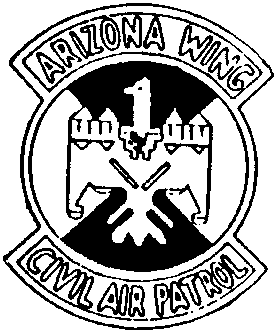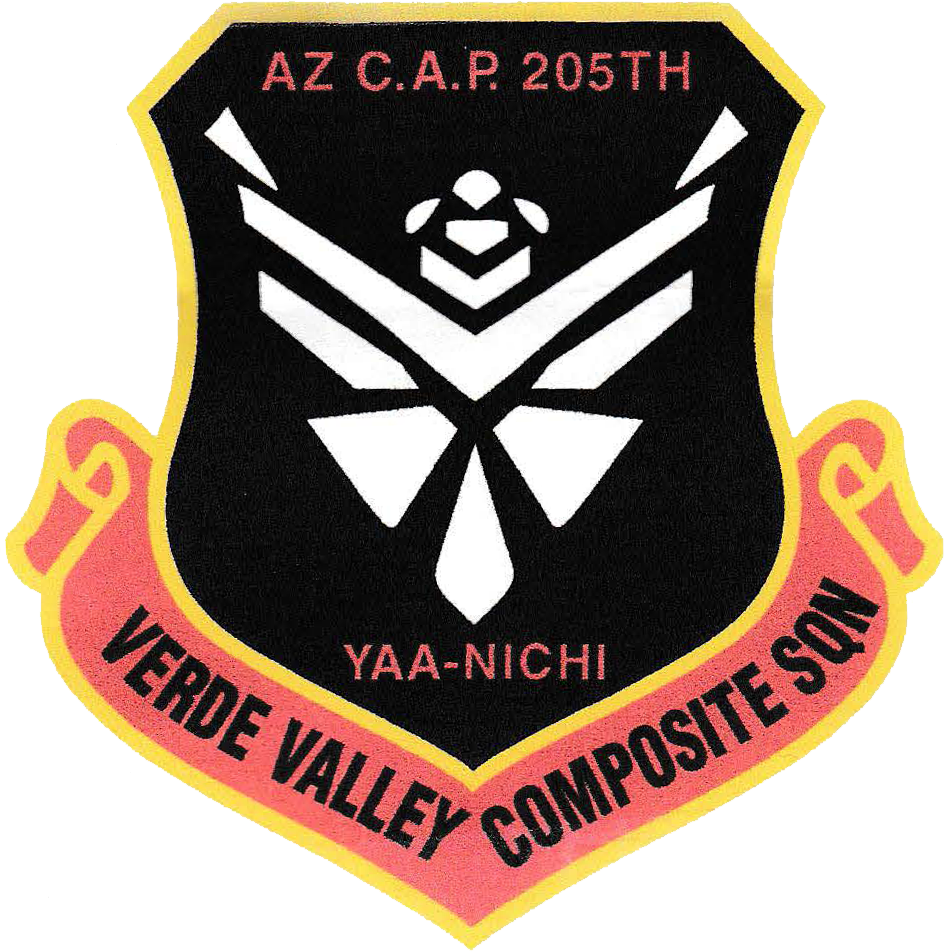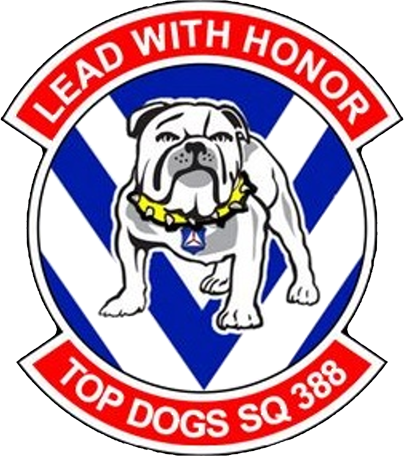


"Artwork to a Navajo Indian is like a written letter to almost anyone else. A Navajo, 1st Lt Ned A Hatathli, designed the patch Arizona Wing members so proudly wear today. The Thunderbird, the primary design, is a symbol of good luck and each of the symbol's colors bears a separate meaning. The gray and blue body represents the color of Civil Air Patrol aircraft. The Thunderbird's wings are shaped to look like a building or hospital, while the tail represents the wings and stabilizers of an aircraft. The 'V' in the middle of the body represents the many landing fields on the Navajo Reservation. The black to the north represents an evil spirit; the white to the east represents the rising sun; the blue to the south represents the heavens; and the yellow to the west is the setting sun."
"Lieutenant Hatathli designed the Arizona Wing patch as a 'thank you'. A full-blood Navajo, who was descended from a Navajo medicine man, he could do nothing when his little girl, Gloria, then 4, was stricken with a serious illness. Hatathli and his family lived on the Navajo Reservation far away from help. The Civil Air Patrol stepped in to help. An Arizona Wing aircrew picked up Gloria on Christmas Day 1952 and flew her to Phoenix, where she could get help. The illness was identified as bulbar polio and the young girl was flown to Hot Springs for treatment. When Gloria Hatathli was able to return to her home, she wore a leg brace, which doctors told the lieutenant she could eventually discard. Then the Navajo Arts and Crafts Center manager, Lieutenant Hatathli joined the Civil Air Patrol and accepted a position as Window Rock Composite Squadron supply officer. He designed the wing patch specifically for Arizona Wing in gratitude of services rendered to help Gloria. Lieutenant Hatathli later became the first president of the Navajo Community College. He died in 1972 after a long and distinguished career as an educator and tribal leader. Today, Gloria still lives on the reservation. Lieutenant Hatathli's wing patch design was accepted and in February 1953 earned approval of the Civil Air Patrol National Headquarters."
Information provided by:
Captain Joyce Kienitz, Arizona Wing Public Affairs

The eagle, yellow and black checkered shield and CAP triangle with propeller were taken from the original squadron patch design. The eagle represents protection and the black and gold checkered shield representing honor and determination. Inside the shield is the historic Civil Air Patrol triangle and prop symbol. The three sides of the triangle represent each of the missions for CAP, set forth by Congress in 1946: Aerospace, Cadet Programs and Emergency Services.
Behind the insignia is the Arizona Flag with its alternating gold and red rays and over a blue field. The rays represent the original 13 colonies and the gold and red colors were carried by Coronado's Spanish expedition in search of the seven cities ofCibola in 1540. The blue field is the same blue found in the United States ' Flag which represents Liberty. The Roman numeral MCML VII within the blue field is the year in which Squadron 304 was originally charted in 1598.
The encompassing circle in grey honors Hawk Mountain Ranger Training School in Kempton, P A. The school's legacy is in emergency services training for CAP members in Search and Rescue. The Squadron unit number 304 is reflected by Roman numeral CCCIV. Finally, the grey circle is supported by the red ribbon below describing the Civil Air Patrol's motto Semper Vigilans.
The patch was designed by Major Kenneth Canteen and approved c.2008-2009.
Information provided by:
Capt Keith Hakeman, Squadron Commander

The squadron patch is similar to the Arizona state flag with the gold and red rays and the sea of blue. This honors the state the squadron represents. The 3-bladed propeller is symbolic of the 3-bladed propeller that represents CAP and its three missions. The word "TUNATYAWMA" is from Hopi Tribal folklore. In Hopi folklore, the coyote is the main character in many stories where it interacts with many other creatures. He is considered clever in many stories and then a fool in others. The meaning of "TUNATYAWMA" means to "guide as you go" or to "watch your way."
The Dan Kenney Composite Squadron was chartered by Civil Air Patrol in May of 1979. The squadron was originally named the Flagstaff Composite Squadron until the squadron changed its name when longtime member Dan Kenney passed away in 1986. Dan Kenney was a very active CAP member and an excellent pilot. Dan was instrumental in CAP and helped our local squadron gain prominence for all the hard work he did. This is the reason why the squadron bares his name. Dan Kenney was honored by the Arizona Wing by adding his name to the Wing's Hall of Honor.
Information provided by:
Dan Kenney Composite Squadron 201
September 3, 2010

The symbolism of the design is as follows:
Information provided by:
Lt Col David M Alegre, Squadron Commander
June 1, 2016

 A 2-1/2 inch-wide, 2-3/4 inch-long shield trimmed with a yellow line; the shield is black; at the top the letters in red "AZ C.A.P. 205TH"; in the center is the updated version of the current white "Thunderbird"; at the bottom in red letters "YAA-NICHI", the motto of the squadron, which is Navajo for "To Honor It Highly". At the bottom of the shield is a red scroll with yellow trim and the words "VERDE VALLEY COMPOSITE SQDN" in black.
A 2-1/2 inch-wide, 2-3/4 inch-long shield trimmed with a yellow line; the shield is black; at the top the letters in red "AZ C.A.P. 205TH"; in the center is the updated version of the current white "Thunderbird"; at the bottom in red letters "YAA-NICHI", the motto of the squadron, which is Navajo for "To Honor It Highly". At the bottom of the shield is a red scroll with yellow trim and the words "VERDE VALLEY COMPOSITE SQDN" in black.
The patch was designed by C/2d Lt Josh Edgerton, approved by squadron commander 1st Lt Bill Tinnin, and authorized by Colonel John Varljen, Arizona Wing Commander in April 2004.
Information provided by:
Capt Jean-Marie Nixon,
Squadron Deputy Commander for Cadets
June 27, 2016

In 2006, Capt. Oscar M. Cordero and Squadron Commander asked cadets to summit patch designs and the one with the most votes would be selected as the
unitís patch. After all votes were casted, the "bat patch" was selected and it was designed by Captai Cordero. The patch features a black bat in mid-
flight on a night sky with white stars.
A bat was chosen as a mascot for two reasons. The most important, because it is very representative of the squadronís Sonoran Desert landscape in
Nogales, AZ and it isnít hard to run into them at dawn. The second reason is because their echolocation resembles the technique used to find ELTís.
Three white stars surround the bat. Each star represents one of CAPís missions and the three of them form a propeller constellation, which is another CAP
identifier.
Information provided by:
Oscar Cordero
Former Commander, Santa Cruz County Comp Sq 101
September 4, 2015

The significance of the design is as follows:
The mountains represent the ranges surrounding Tucson, prominently visible from the entire city. The Arizona state flag is in the background. The squadron motto, "Where Excellence Begins" is prominently featured on a field of white. The A-10 in the center honors the squadron's founding member, Lt Col Mike Meier, who was an A -1 0 pilot for most of his Air Force career.
Information provided by:
C/Capt Andrew Varnes,
East Tucson Cadet Squadron 229
July 27, 2016

 Heraldry Significance in Design and Motto
Heraldry Significance in Design and Motto
The 388th Composite Squadron's Patch Design main item is a bulldog representing the title "Top Dogs" associated with the 61st Fighter Squadron located at Luke Air Force Base, Arizona. On the bulldog are three main colors: white, grey and black. These three colors represent the three missions of Civil Air Patrol (emergency services, aerospace education, and cadet programs).
The bulldog centered on the emblem is collared with a yellow collar. The color yellow represents the "íthe suní and the excellence required of Air Force personnel" as well as the honor in which Squadron 388 carries themselves.
Below the collar is the tag of the bulldog. The tag is in the shape of the Civil Air Patrol mission symbol. This symbol represents what Civil Air Patrol is and the foundation from where Squadron 388 comes.
Behind the bulldog, is a blue and white stripped background in the shape of a "V". The blue represents "íthe skyí, the primary theater of Air Force operations". The white represents the purity of Squadron 388 as it is a new squadron developing from the ashes of the old. The "V" shaped background represents the Civil Air Patrol motto, "Semper Vigilans" - Latin for Always Vigilant.
Around the symbol you will see a white outline. Above and below the white outline are words backed in red. The red background on the bottom scroll represents fire. As three former squadrons were burnt down (dissolved), and the ashes (members) of their past were used to create a new squadron. The red background on the top scroll represents strength and courage, as it is not the absence of fear but the will to face it. Squadron 388 has come together by facing that fear. The members of past squadrons entered the new squadron clueless of the outcome but had the strength to carry on.
The bottom scroll states the Squadron lD, 388, along with the Squadron Mascot, Top Dogs. The top scroll has the Squadron motto, Lead with Honor. Coming from a book with a similar name, Leading with Honor: Leadership Lessons from the Hanoi Hilton (paperback, January 2014) by Lee Ellis with a forward by Senator John McCain. The reasoning behind this is Squadron 388 believes in servant leadership, meaning a leader is a servant first. This Squadron is built on certain foundations, and we are held to them every day. They are willing to honorably serve the community and enforce a system of belief to better us all in the outcome.
Information provided by:
Maj Ken Mann, Squadron Commander
March 28, 2016